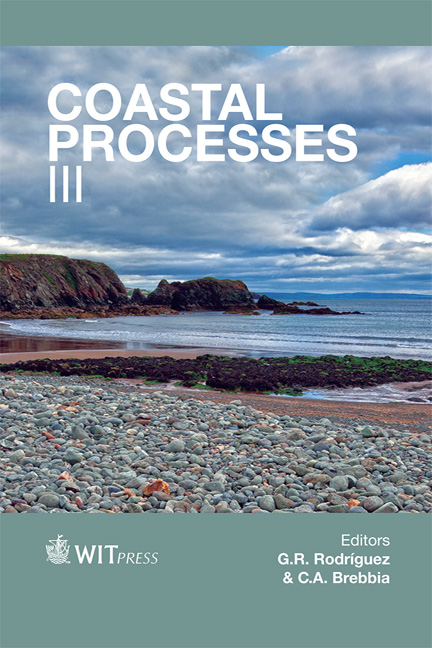Water Level Modulation Of Current Vectors And Sediment Flux In A Transverse Bar-rip Cell
Price
Free (open access)
Transaction
Volume
169
Pages
15
Page Range
203 - 217
Published
2013
Size
1,979 kb
Paper DOI
10.2495/CP130181
Copyright
WIT Press
Author(s)
B. Greenwood, R. W. Brander, B. Perez, E. Joseph & J. Z. Li
Abstract
Measurements of mean water level and surface waves (Druck 1830 piezoresistive transducers and PlexiglasTM stilling wells), shore-parallel and shorenormal currents (Marsh-McBirney OEM512 electromagnetic current meters), and suspended sediment concentrations (D&A Instruments OBS1P and OBS3 optical backscatter sensors) were recorded continuously at 4 Hz within a microtidal transverse bar-rip cell at Bennett’s Beach, NSW, Australia. Currents (at elevations of z = 0.13, 0.39, 0.50 m) and sediment concentrations (at z = 0.13, 0.26, 0.39 m) were recorded under low to moderate swell during spring tides at three key locations: (a) transverse bar crest; (b) rip feeder current channel; (c) rip channel neck. Current roses illustrated the rip cell flow patterns (8-minute records every 15 minutes) over the tidal cycle. Velocity vectors in the rip neck revealed: (i) maxima (1.50–1.75 m s-1) at high water and minima at low water in contrast with other data for bathymetrically constrained rips; (ii) directionally well-constrained, but highly unsteady, currents. Currents in the feeder channel were: (i) the most variable in terms of speed and direction, with an angular spread of > 200°; (ii) actually opposed to the mean flow in some cases; this reflects either extreme meandering or more likely the presence of large-scale vorticity superimposed on the mean flow, similar to the large Lagrangian structures detected by others. Breaking waves on the bar crest produced flow vectors reflecting: (i) a strong longshore current; (ii) an onshore mass transport; (iii) a distinct undertow. Vector variability was the major influence on the timeaveraged mean suspended sediment transport within the rip neck. Keywords: tidal phase, rip cell circulation, current and sediment flux vectors.
Keywords
tidal phase, rip cell circulation, current and sediment flux vectors.





